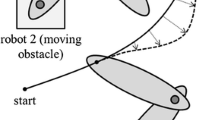Abstract
We present a new approach to path planning based on the properties of the minimum enclosing ball (MEB) in a reproducing kernel space. The algorithm is designed to find paths in high-dimensional continuous spaces and can be applied to robots with many degrees of freedom in static as well as dynamic environments. In the proposed method a sample of points from free space is enclosed in a kernel space MEB. In this way the interior of the MEB becomes a representation of free space in kernel space. If both start and goal positions are interior points in the MEB a collision-free path is given by the line, contained in the MEB, connecting them. The points in work space that satisfy the implicit conditions for that line in kernel space define the desired path. The proposed algorithm was experimentally tested on a workspace cluttered with random and non random distributed obstacles. With very little computational effort, in all cases, a satisfactory free collision path could be calculated.
Access this chapter
Tax calculation will be finalised at checkout
Purchases are for personal use only
Preview
Unable to display preview. Download preview PDF.
Similar content being viewed by others
References
Latombe, J.C.: Motion planning: A journey of robots, molecules, digital actors and other artifacts. Journal of Robotics Research (Especial Issue on Robotics at the Millenium) 18(Part II), 1119–1128 (1999)
Latombe, J.C.: Robot Motion Planning. Kluwer Academic Publisher, Boston (1991)
LaValle, S.: Planning algorithms (2004), available at http://msl.cs.uiuc.edu/planning
Caselli, S., Reggiani, M., Rocchi, R.: Heuristic methods for randomized path planning in potential fields. In: IEEE International Symposium on Computational Intelligence in Robotics and Automation, pp. 426–431 (2001)
Amato, N., Wu, Y.: A randomized roadmap for path manipulation planning. In: IEEE International Conference on Robotics and Automation, pp. 113–120 (1996)
Kavraki, L., Latombe, J.: Randomized preprocessing of configurations space for path planning. In: IEEE International Conference on Robotics and Automation, pp. 2138–2139 (1994)
Behring, C., Bracho, M., Castro, M., Moreno, J.: An algorithm for robot path planning with cellular automata. In: Theoretical and Practical Issues on Cellular Automata, pp. 11–19. Springer, Berlin (2000)
Bracho de Rodríguez, M., Moreno, J.A.: Heuristic algorithm for robot path planning based on real space renormalization. In: Monard, M.C., Sichman, J.S. (eds.) SBIA 2000 and IBERAMIA 2000. LNCS (LNAI), vol. 1952, pp. 379–388. Springer, Heidelberg (2000)
Moreno, J., Castro, M.: Heuristic algorithm for robot path planning based on a growing elastic net. In: Bento, C., Cardoso, A., Dias, G. (eds.) EPIA 2005. LNCS (LNAI), vol. 3808, pp. 447–454. Springer, Heidelberg (2005)
LaValle, S.: Rapidly-exploring random trees: A new tool for path planning. Technical Report Technical Report TR 98-11, Computer Science Dept. Iowa State Univ (Oct. 1998)
Canny, J.: The Complexity of Robot Motion Planning. MIT Press, Cambridge (1988)
Scholkopf, B., Smola, A.: Learning with Kernels: Support Vector Machines, Regularization, Optimization and Beyond. The MIT Press, Cambridge (2002)
Scholkopf, B., Burges, J., Smola, A.: Advances in Kernel Methods - Support Vector Learning. The MIT Press, Cambridge (1999)
Badoiu, M., Clarkson, K.L.: Optimal core-sets for balls. In: DIMACS Workshop on Computational Geometry (2002)
Kumar, P., Mitchell, J., Yildirim, E.A.: Computing core-sets and approximate smallest enclosing hyperspheres in high dimensions. In: Proceedings of the 5th Workshop on Algorithm Engineering and Experiments - ALENEX’03 (2003)
Badoiu, M., Har-Peled, S., Indyk, P.: Approximate clustering via core-sets. In: Proceedings of the 34th Symposium on Theory of Computing (2002)
Author information
Authors and Affiliations
Editor information
Rights and permissions
Copyright information
© 2007 Springer Berlin Heidelberg
About this paper
Cite this paper
Moreno, J.A., García, C. (2007). Robot Path Planning in Kernel Space. In: Beliczynski, B., Dzielinski, A., Iwanowski, M., Ribeiro, B. (eds) Adaptive and Natural Computing Algorithms. ICANNGA 2007. Lecture Notes in Computer Science, vol 4432. Springer, Berlin, Heidelberg. https://doi.org/10.1007/978-3-540-71629-7_75
Download citation
DOI: https://doi.org/10.1007/978-3-540-71629-7_75
Publisher Name: Springer, Berlin, Heidelberg
Print ISBN: 978-3-540-71590-0
Online ISBN: 978-3-540-71629-7
eBook Packages: Computer ScienceComputer Science (R0)




